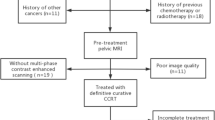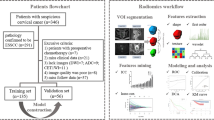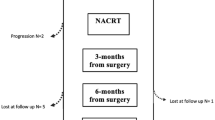Abstract
Purpose
To investigate the value of magnetic resonance imaging (MRI)-based radiomics in predicting the treatment response to concurrent chemoradiotherapy (CCRT) in patients with locally advanced cervical squamous cell cancer (LACSC).
Methods
In total, 198 patients (training: n = 138; testing: n = 60) with LACSC treated with CCRT between January 2014 and December 2019 were retrospectively enrolled in this study. Responses were evaluated by MRI and clinical data performed at one month after completion of CCRT according to RECIST standards, and patients were divided into the residual group and nonresidual group. Overall, 200 radiomics features were extracted from T2-weighted imaging and apparent diffusion coefficient maps. The radiomics score (Rad-score) was constructed with a feature selection strategy. Logistic regression analysis was used for multivariate analysis of radiomics features and clinical variables. The performance of all models was assessed using receiver operating characteristic curves.
Results
Among the clinical variables, tumor grade and FIGO stage were independent risk factors, and the areas under the curve (AUCs) of the clinical model were 0.741 and 0.749 in the training and testing groups. The Rad-score, consisting of 4 radiomics features selected from 200 radiomics features, showed good predictive performance with an AUC of 0.819 in the training group and 0.776 in the testing group, which were higher than the clinical model, but the difference was not statistically significant. The combined model constructed with tumor grade, FIGO stage, and Rad-score achieved the best performance, with an AUC of 0.857 in the training group and 0.842 in the testing group, which were significantly higher than the clinical model.
Conclusion
MRI-based radiomics features could be used as a noninvasive biomarker to improve the ability to predict the treatment response to CCRT in patients with LACSC.




Similar content being viewed by others
References
Sung, H., Ferlay, J., Siegel, R. L., Laversanne, M., Soerjomataram, I., Jemal, A., Bray, F (2021) Global Cancer Statistics 2020: GLOBOCAN Estimates of Incidence and Mortality Worldwide for 36 Cancers in 185 Countries. CA Cancer J Clin 71(3):209-249. https://doi.org/10.3322/caac.21660
Bhatla, N., Aoki, D., Sharma, D. N., Sankaranarayanan, R (2018) Cancer of the cervix uteri. Int J Gynaecol Obstet 143 Suppl 2:22-36. https://doi.org/10.1002/ijgo.12611
Fujiwara H, Yokota H, Monk B, et al (2014) Gynecologic Cancer InterGroup (GCIG) consensus review for cervical adenocarcinoma. Int J Gynecol Cancer 24(9 Suppl 3):S96-101. https://doi.org/10.1097/IGC.0000000000000263
Koh WJ, Abu-Rustum NR, Bean S, et al (2019) Cervical Cancer, version 3.2019, NCCN clinical practice guidelines in oncology. J Natl Compr Canc Netw 17(1):64-84. https://doi.org/10.6004/jnccn.2019.0001
Lyng H, Vorren AO, Sundfor K, Taksdal I, Lien HH, Kaalhus O, et al (2001) Intra- and intertumor heterogeneity in blood perfusion of human cervical cancer before treatment and after radiotherapy. Int J Cancer 96(3):182-190. https://doi.org/10.1002/ijc.1019
Chereau E, DE LA Hosseraye C, Ballester M, et al (2013) The role of completion surgery after concurrent radiochemotherapy in locally advanced stages IB2-IIB cervical cancer. Anticancer Res 33:1661-1666
Leguevaque P, Motton S, Delannes M, et al (2011) Completion surgery or not after concurrent chemoradiotherapy for locally advanced cervical cancer? Eur J Obstet Gynecol Reprod Biol 155:188-192. https://doi.org/10.1016/j.ejogrb.2010.11.016
Tangjitgamol S, Katanyoo K, Laopaiboon M, Lumbiganon P, Manusirivithaya S, Supawattanabodee B (2014) Adjuvant chemotherapy after concurrent chemoradiation for locally advanced cervical cancer. Cochrane Database Syst Rev 12: (Cd010401). https://doi.org/10.1002/14651858.CD010401.pub2
Yang W, Qiang JW, Tian HP, Chen B, Wang AJ, Zhao JG (2018) Multi-parametric MRI in cervical cancer: early prediction of response to concurrent chemoradiotherapy in combination with clinical prognostic factors. Eur Radiol 28(1):437-445. https://doi.org/10.1007/s00330-017-4989-3
Ai Y, Zhu H, Xie C, Jin X (2020) Radiomics in cervical cancer: Current applications and future potential. Crit Rev Oncol Hematol 152:102985. https://doi.org/10.1016/j.critrevonc.2020.102985
Laliscia C, Gadducci A, Mattioni R, et al (2021) MRI-based radiomics: promise for locally advanced cervical cancer treated with a tailored integrated therapeutic approach. Tumori 3008916211014274. https://doi.org/10.1177/03008916211014274
Manganaro L, Lakhman Y, Bharwani N, Gui B, Gigli S, Vinci V, et al (2021) Staging, recurrence and follow-up of uterine cervical cancer using MRI: Updated Guidelines of the European Society of Urogenital Radiology after revised FIGO staging 2018. Eur Radiol 31(10):7802-7816. https://doi.org/10.1007/s00330-020-07632-9
Zheng X, Guo W, Dong J, Qian L (2020) Prediction of early response to concurrent chemoradiotherapy in cervical cancer: Value of multi-parameter MRI combined with clinical prognostic factors. Magn Reson Imaging 72:159-166. https://doi.org/10.1016/j.mri.2020.06.014
Su TP, Lin G, Huang YT, et al (2018) Comparison of positron emission tomography/computed tomography and magnetic resonance imaging for posttherapy evaluation in patients with advanced cervical cancer receiving definitive concurrent chemoradiotherapy. Eur J Nucl Med Mol Imaging 45(5):727-734. https://doi.org/10.1007/s00259-017-3884-0
Barwick TD, Taylor A, Rockall A (2013) Functional imaging to predict tumor response in locally advanced cervical cancer. Curr Oncol Rep 15(6):549-558. https://doi.org/10.1007/s11912-013-0344-2
Cui Y, Yang X, Shi Z, et al (2019) Radiomics analysis of multiparametric MRI for prediction of pathological complete response to neoadjuvant chemoradiotherapy in locally advanced rectal cancer. Eur Radiol 29(3):1211-1220. https://doi.org/10.1007/s00330-018-5683-9
Traverso A, Wee L and Gillies R (2018) Repeatability and reproducibility of radiomic features: a systematic review. Int J Radiat Oncol Biol Phys 102:1143-1158. https://doi.org/10.1016/j.ijrobp.2018.05.053
Junttila MR, de Sauvage FJ (2013) Influence of tumour microenvironment heterogeneity on therapeutic response. Nature 501(7467):346-54. https://doi.org/10.1038/nature12626
Tomaszewski MR, Gillies RJ (2021) The Biological Meaning of Radiomic Features. Radiology 298(3);505-516. https://doi.org/10.1148/radiol.2021202553
Gui B, Autorino R, Miccò M, et al (2021) Pretreatment MRI Radiomics Based Response Prediction Model in Locally Advanced Cervical Cancer. Diagnostics (Basel) 11(4):631. https://doi.org/10.3390/diagnostics11040631
Eun NL, Kang D, Son EJ, et al (2020) Texture Analysis with 3.0-T MRI for Association of Response to Neoadjuvant Chemotherapy in Breast Cancer. Radiology 294(1):31-41. https://doi.org/10.1148/radiol.2019182718
Liu Z, Zhang XY, Shi YJ, et al (2017) Radiomics Analysis for Evaluation of Pathological Complete Response to Neoadjuvant Chemoradiotherapy in Locally Advanced Rectal Cancer. Clin Cancer Res 23(23):7253-7262. https://doi.org/10.1158/1078-0432.CCR-17-1038
Bhatla N, Berek JS, Cuello Fredes M, et al (2019) Revised FIGO staging for carcinoma of the cervix uteri. Int J Gynaecol Obstet 147:279-280. https://doi.org/10.1002/ijgo.12749
Olawaiye AB, Baker TP, Washington MK, Mutch DG (2021) The new (Version 9) American Joint Committee on Cancer tumor, node, metastasis staging for cervical cancer. CA Cancer J Clin 71:287-298. https://doi.org/10.3322/caac.21663
Watanabe H, Okada M, Kaji Y, Satouchi M, Sato Y, Yamabe Y, et al (2009) [New response evaluation criteria in solid tumours-revised RECIST guideline (version 1.1)]. Gan To Kagaku Ryoho 36(13):2495-2501.
Rose PG, Java J, Whitney CW, Stehman FB, Lanciano R, Thomas GM, et al (2015) Nomograms Predicting Progression-Free Survival, Overall Survival, and Pelvic Recurrence in Locally Advanced Cervical Cancer Developed From an Analysis of Identifiable Prognostic Factors in Patients From NRG Oncology/Gynecologic Oncology Group Randomized Trials of Chemoradiotherapy. J Clin Oncol 33(19):2136-42. https://doi.org/10.1200/JCO.2014.57.7122
Liu X, Wang J, Hu K et al (2020) Validation of the 2018 FIGO Staging System of cervical cancer for stage III patients with a cohort from China. Cancer Manag Res 12:1405-1410. https://doi.org/10.2147/CMAR.S239624
Cancer Genome Atlas Research Network; Albert Einstein College of Medicine; Analytical Biological Services (2017) Integrated genomic and molecular characterization of cervical cancer. Nature 543(7645):378-384. https://doi.org/10.1038/nature21386
Randall ME, Michael H, Long H, Tedjarati S (2009) Uterine cervix. In: Barakat RR, Markman M, Randall ME(ed) Principles and practice of gynecologic oncology. 5th ed. Philadelphia, PA: Wolters Kluwer/Lippincott Williams & Wilkins, pp 623-81.
Matsuo K, Mandelbaum RS, Machida H et al (2018) Association of tumor differentiation grade and survival of women with squamous cell carcinoma of the uterine cervix. J Gynecol Oncol 29(6):e91. https://doi.org/10.3802/jgo.2018.29.e91
Gillies RJ, Kinahan PE, Hricak H (2016) Radiomics: Images Are More than Pictures, They Are Data. Radiology 278(2): 563-77. https://doi.org/10.1148/radiol.2015151169
Li Z, Li H, Wang S, et al (2018) MR-Based Radiomics Nomogram of Cervical Cancer in Prediction of the Lymph-Vascular Space Invasion preoperatively. J Magn Reson Imaging 49(5): 1420-1426. https://doi.org/10.1002/jmri.26531
Wu Q, Wang S, Chen X, et al (2019) Radiomics analysis of magnetic resonance imaging improves diagnostic performance of lymph node metastasis in patients with cervical cancer. Radiother Oncol 138:141-148. https://doi.org/10.1016/j.radonc.2019.04.035
Fang J, Zhang B, Wang S, et al (2020) Association of MRI-derived radiomic biomarker with disease-free survival in patients with early-stage cervical cancer. Theranostics 10(5):2284-2292. https://doi.org/10.7150/thno.37429
Sun C, Tian X, Liu Z, et al (2019) Radiomic analysis for pretreatment prediction of response to neoadjuvant chemotherapy in locally advanced cervical cancer: A multicentre study. EBioMedicine 46:160-169. https://doi.org/10.1016/j.ebiom.2019.07.049
Bowen SR, Yuh WTC, Hippe DS, et al (2018) Tumor radiomic heterogeneity: Multiparametric functional imaging to characterize variability and predict response following cervical cancer radiation therapy. J Magn Reson Imaging 47(5):1388-1396. https://doi.org/10.1002/jmri.25874
Hameeduddin A, Sahdev A (2015) Diffusion-weighted imaging and dynamic contrast-enhanced MRI in assessing response and recurrent disease in gynaecological malignancies. Cancer Imaging 15(1):3. https://doi.org/10.1186/s40644-015-0037-1
Schreuder SM, Lensing R, Stoker J, Bipat S (2015) Monitoring treatment response in patients undergoing chemoradiotherapy for locally advanced uterine cervical cancer by additional diffusion-weighted imaging: A systematic review. J Magn Reson Imaging 42(3);572-594. https://doi.org/10.1002/jmri.24784
Gladwish A, Milosevic M, Fyles A, et al (2016) Association of Apparent Diffusion Coefficient with Disease Recurrence in Patients with Locally Advanced Cervical Cancer Treated with Radical Chemotherapy and Radiation Therapy. Radiology 279(1):158-166. https://doi.org/10.1148/radiol.2015150400
Hompland T, Ellingsen C, Galappathi K, Rofstad EK (2014) DW-MRI in assessment of the hypoxic fraction, interstitial fluid pressure, and metastatic propensity of melanoma xenografts. BMC Cancer 14:92. https://doi.org/10.1186/1471-2407-14-92
Funding
No funding was received for this study.
Author information
Authors and Affiliations
Contributions
XZ, QZ, XY, and XZ contributed to conceptualization; XZ, QZ, YC, and SW contributed to methodology; XZ, SW, JZ, JA, LX, and XY contributed to formal analysis and investigation; XZ and QZ contributed to writing—original draft preparation; YC and XY contributed to writing—review and editing; XZ contributed to supervision.
Corresponding authors
Ethics declarations
Conflict of interest
The authors have no relevant financial or non-financial interests to disclose.
Ethical approval
The study was approved by the Ethics Committee of National Cancer Center/National Clinical Research Center for Cancer/Cancer Hospital, Chinese Academy of Medical Sciences and Peking Union Medical College.
Consent to participate
Informed consent was waived.
Consent for publication
Not applicable.
Additional information
Publisher's Note
Springer Nature remains neutral with regard to jurisdictional claims in published maps and institutional affiliations.
Supplementary Information
Below is the link to the electronic supplementary material.
Rights and permissions
Springer Nature or its licensor holds exclusive rights to this article under a publishing agreement with the author(s) or other rightsholder(s); author self-archiving of the accepted manuscript version of this article is solely governed by the terms of such publishing agreement and applicable law.
About this article
Cite this article
Zhang, X., Zhang, Q., Chen, Y. et al. MRI-based radiomics for pretreatment prediction of response to concurrent chemoradiotherapy in locally advanced cervical squamous cell cancer. Abdom Radiol 48, 367–376 (2023). https://doi.org/10.1007/s00261-022-03665-4
Received:
Revised:
Accepted:
Published:
Issue Date:
DOI: https://doi.org/10.1007/s00261-022-03665-4




